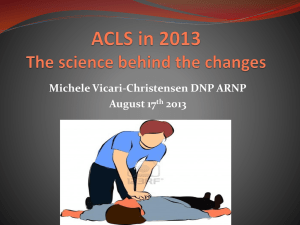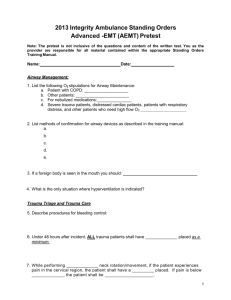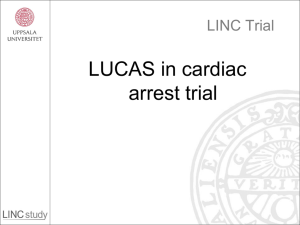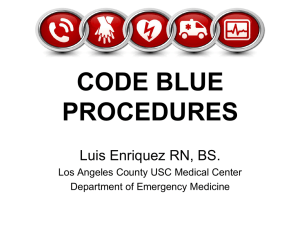Pediatric BLS/PALS Science Update 2010
advertisement
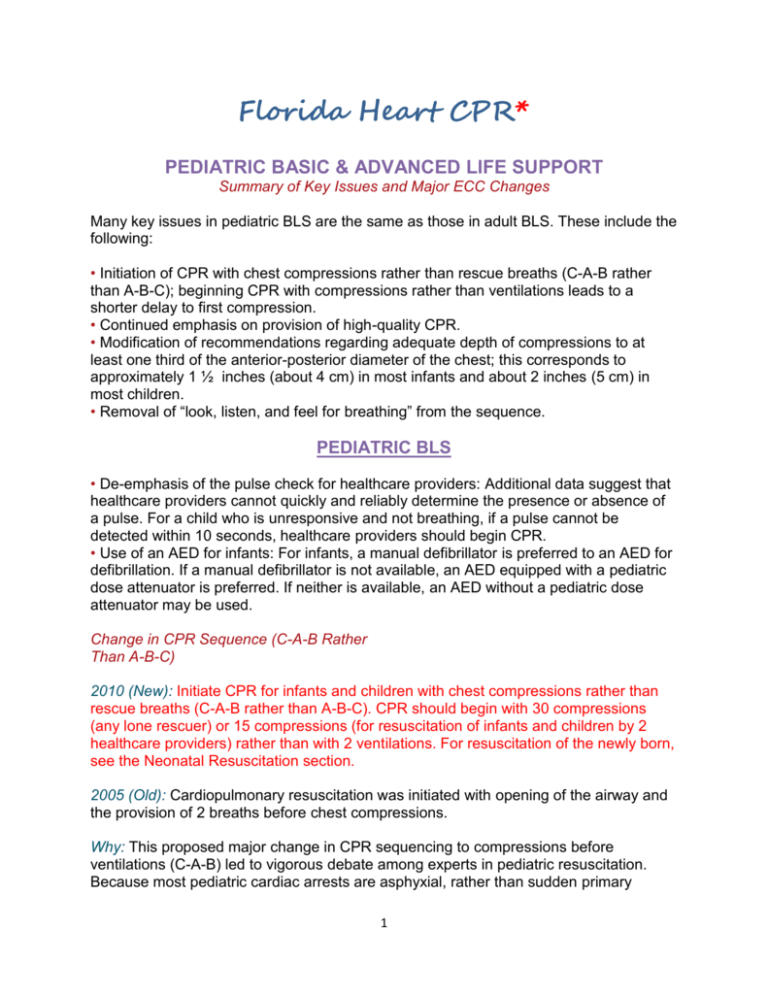
Florida Heart CPR* PEDIATRIC BASIC & ADVANCED LIFE SUPPORT Summary of Key Issues and Major ECC Changes Many key issues in pediatric BLS are the same as those in adult BLS. These include the following: • Initiation of CPR with chest compressions rather than rescue breaths (C-A-B rather than A-B-C); beginning CPR with compressions rather than ventilations leads to a shorter delay to first compression. • Continued emphasis on provision of high-quality CPR. • Modification of recommendations regarding adequate depth of compressions to at least one third of the anterior-posterior diameter of the chest; this corresponds to approximately 1 ½ inches (about 4 cm) in most infants and about 2 inches (5 cm) in most children. • Removal of “look, listen, and feel for breathing” from the sequence. PEDIATRIC BLS 19 • De-emphasis of the pulse check for healthcare providers: Additional data suggest that healthcare providers cannot quickly and reliably determine the presence or absence of a pulse. For a child who is unresponsive and not breathing, if a pulse cannot be detected within 10 seconds, healthcare providers should begin CPR. • Use of an AED for infants: For infants, a manual defibrillator is preferred to an AED for defibrillation. If a manual defibrillator is not available, an AED equipped with a pediatric dose attenuator is preferred. If neither is available, an AED without a pediatric dose attenuator may be used. Change in CPR Sequence (C-A-B Rather Than A-B-C) 2010 (New): Initiate CPR for infants and children with chest compressions rather than rescue breaths (C-A-B rather than A-B-C). CPR should begin with 30 compressions (any lone rescuer) or 15 compressions (for resuscitation of infants and children by 2 healthcare providers) rather than with 2 ventilations. For resuscitation of the newly born, see the Neonatal Resuscitation section. 2005 (Old): Cardiopulmonary resuscitation was initiated with opening of the airway and the provision of 2 breaths before chest compressions. Why: This proposed major change in CPR sequencing to compressions before ventilations (C-A-B) led to vigorous debate among experts in pediatric resuscitation. Because most pediatric cardiac arrests are asphyxial, rather than sudden primary 1 cardiac arrests, both intuition and clinical data support the need for ventilations and compressions for pediatric CPR. However, pediatric cardiac arrests are much less common than adult sudden (primary) cardiac arrests, and many rescuers do nothing because they are uncertain or confused. Most pediatric cardiac arrest victims do not receive any bystander CPR, so any strategy that improves the likelihood of bystander action may save lives. Therefore, the C-A-B approach for victims of all ages was adopted with the hope of improving the chance that bystander CPR would be performed. The new sequence should theoretically only delay rescue breaths by about 18 seconds (the time it takes to deliver 30 compressions) or less (with 2 rescuers). Chest Compression Depth 2010 (New): To achieve effective chest compressions, rescuers should compress at least one third of the anterior-posterior diameter of the chest. This corresponds to approximately 1 ½ inches (about 4 cm) in most infants and about 2 inches (5 cm) in most children. 2005 (Old): Push with sufficient force to depress the chest approximately one third to one half the anterior-posterior diameter of the chest. Why: Evidence from radiologic studies of the chest in children suggests that compression to one half the anterior-posterior diameter may not be achievable. However, effective chest compressions require pushing hard, and based on new data, the depth of about 1 ½ inches (4 cm) for most infants and about 2 inches (5 cm) in most children is recommended. Elimination of “Look, Listen, and Feel 2010 (New): “Look, listen, and feel” was removed from the sequence for assessment of breathing after opening the airway. 2005 (Old): “Look, listen, and feel” was used to assess breathing after the airway was opened. Why: With the new chest compression–first sequence, CPR is performed if the infant or child is unresponsive and not breathing (or only gasping) and begins with compressions (C-A-B sequence). Pulse Check Again De-emphasized 2010 (New): If the infant or child is unresponsive and not breathing or only gasping, healthcare providers may take up to 10 seconds to attempt to feel for a pulse (brachial in an infant and carotid or femoral in a child). If, within 10 seconds, you don’t feel a pulse or are not sure if you feel a pulse, begin chest compressions. It can be difficult to determine the presence or absence of a pulse, especially in an emergency, and studies 2 show that both healthcare providers and lay rescuers are unable to reliably detect a pulse. 2005 (Old): If you are a healthcare provider, try to palpate a pulse. Take no more than 10 seconds. Why: The recommendation is the same, but there is additional evidence to suggest that healthcare providers cannot reliably and rapidly detect either the presence or the absence of a pulse in children. Given the risk of not providing chest compressions for a cardiac arrest victim and the relatively minimal risk of providing chest compressions when a pulse is present, the 2010 AHA Guidelines for CPR and ECC recommend compressions if a rescuer is unsure about the presence of a pulse. Defibrillation and Use of the AED in Infants 2010 (New): For infants, a manual defibrillator is preferred to an AED for defibrillation. If a manual defibrillator is not available, an AED equipped with a pediatric dose attenuator is preferred. If neither is available, an AED without a pediatric dose attenuator may be used. 2005 (Old): Data have shown that AEDs can be used safely and effectively in children 1 to 8 years of age. However, there are insufficient data to make a recommendation for or against using an AED in infants <1 year of age. Why: Newer case reports suggest that an AED may be safe and effective in infants. Because survival requires defibrillation when a shockable rhythm is present during cardiac arrest, delivery of a high-dose shock is preferable to no shock. Limited evidence supports the safety of AED use in infants. PEDIATRIC ADVANCED LIFE SUPPORT Summary of Key Issues and Major Changes • Many key issues in the review of the PALS literature resulted in refinement of existing recommendations rather than new recommendations; new information is provided for resuscitation of infants and children with selected congenital heart defects and pulmonary hypertension. • Monitoring capnography/capnometry is again recommended to confirm proper endotracheal tube position and may be useful during CPR to assess and optimize the quality of chest compressions. • The PALS cardiac arrest algorithm was simplified to emphasize organization of care around 2-minute periods of uninterrupted CPR. • The initial defibrillation energy dose of 2-4j/kg of either monophasic or biphasic waveform is reasonable; for ease of teaching, a dose of 2j/kg may be used (this dose is the same as in the 2005 recommendation). For second and subsequent doses, give at 3 least 4j/kg. Doses higher than 4j/kg (not to exceed 10j/kg or the adult dose) may also be safe and effective, especially if delivered with a biphasic defibrillator. • On the basis of increasing evidence of potential harm from high oxygen exposure, a new recommendation has been added to titrate inspired oxygen (when appropriate equipment is available), once spontaneous circulation has been restored, to maintain an arterial oxyhemoglobin saturation ≥94% but <100% to limit the risk of hyperoxemia. • New sections have been added on resuscitation of infants and children with congenital heart defects, including single ventricle, palliated single ventricle, and pulmonary hypertension. • Several recommendations for medications have been revised. These include not administering calcium except in very specific circumstances and limiting the use of Etomidate in septic shock. • Indications for post-resuscitation therapeutic hypothermia have been clarified somewhat. • New diagnostic considerations have been developed for sudden cardiac death of unknown etiology. • Providers are advised to seek expert consultation, if possible, when administering amiodarone or procainamide to hemodynamically stable patients with arrhythmias. • The definition of wide-complex tachycardia has been changed from >0.08 second to >0.09 second. Recommendations for Monitoring Exhaled CO2 2010 (New): Exhaled CO2 detection (capnography or colorimetry) is recommended in addition to clinical assessment to confirm tracheal tube position for neonates, infants, and children with a perfusing cardiac rhythm in all settings (eg, pre-hospital, ED, intensive care unit, ward, operating room) and during intra-hospital or interhospital transport (Figure 3A on page 13). Continuous capnography or capnometry monitoring, if available, may be beneficial during CPR to help guide therapy, especially the effectiveness of chest compressions (Figure 3B on page 13). 2005 (Old): In infants and children with a perfusing rhythm, use a colorimetric detector or capnography to detect exhaled CO2 to confirm endotracheal tube position in the prehospital and in-hospital settings and during intrahospital and interhospital transport. Why: Exhaled CO2 monitoring (capnography or colorimetry) generally confirms placement of the endotracheal tube in the airway and may more rapidly indicate endotracheal tube misplacement/displacement than monitoring of oxyhemoglobin saturation. Because patient transport increases the risk for tube displacement, continuous CO2 monitoring is especially important at these times. Animal and adult studies show a strong correlation between PETCO2 concentration and interventions that increase cardiac output during CPR. PETCO2 values consistently <10 to 15 mm Hg suggest that efforts should be focused on improving chest compressions and making sure that ventilation is not excessive. An abrupt and sustained rise in PETCO2 may be observed just before clinical identification of ROSC, so use of PETCO2 monitoring may reduce the need to interrupt chest compressions for a pulse check. 4 Defibrillation Energy Doses 2010 (New): It is acceptable to use an initial dose of 2-4j/kg for defibrillation, but for ease of teaching, an initial dose of 2j/kg may be used. For refractory VF, it is reasonable to increase the dose. Subsequent energy levels should be at least 4j/kg, and higher energy levels, not to exceed 10j/kg or the adult maximum dose, may be considered. 2005 (Old): With a manual defibrillator (monophasic or biphasic), use a dose of 2j/kg for the first attempt and 4j/kg for subsequent attempts. Why: More data are needed to identify the optimal energy dose for pediatric defibrillation. Limited evidence is available about effective or maximum energy doses for pediatric defibrillation, but some data suggest that higher doses may be safe and potentially more effective. Given the limited evidence to support a change, the new recommendation is a minor modification that allows higher doses up to the maximum dose most experts believe is safe. Limiting Oxygen to Normal Levels After Resuscitation 2010 (New): Once the circulation is restored, monitor arterial oxyhemoglobin saturation. It may be reasonable, when the appropriate equipment is available, to titrate oxygen administration to maintain the arterial oxyhemoglobin saturation ≥94%. Provided appropriate equipment is available, once ROSC is achieved, adjust the FIO2 to the minimum concentration needed to achieve arterial oxyhemoglobin saturation ≥94%, with the goal of avoiding hyperoxia while ensuring adequate oxygen delivery. Because an arterial oxyhemoglobin saturation of 100% may correspond to a PaO2 anywhere between approximately 80 and 500 mm Hg, in general it is appropriate to wean the FIO2 when the saturation is 100%, provided the saturation can be maintained ≥94%. 2005 (Old): Hyperoxia and the risk for reperfusion injury were addressed in the 2005 AHA Guidelines for CPR and ECC in general, but recommendations for titration of inspired oxygen were not as specific. Why: In effect, if equipment to titrate oxygen is available, titrate oxygen to keep the oxyhemoglobin saturation 94% to 99%. Data suggest that hyperoxemia (ie, a high PaO2) enhances the oxidative injury observed after ischemia reperfusion such as occurs after resuscitation from cardiac arrest. The risk of oxidative injury may be reduced by titrating the FIO2 to reduce the PaO2 (this is accomplished by monitoring arterial oxyhemoglobin saturation) while ensuring adequate arterial oxygen content. Recent data from an adult study demonstrated worse outcomes with hyperoxia after resuscitation from cardiac arrest. 5 Resuscitation of Infants and Children With Congenital Heart Disease 2010 (New): Specific resuscitation guidance has been added for management of cardiac arrest in infants and children with single-ventricle anatomy, Fontan or hemiFontan/bidirectional Glenn physiology, and pulmonary hypertension. 2005 (Old): These topics were not addressed in the 2005 AHA Guidelines for CPR and ECC. Why: Specific anatomical variants with congenital heart disease present unique challenges for resuscitation. The 2010 AHA Guidelines for CPR and ECC outline recommendations in each of these clinical scenarios. Common to all scenarios is the potential early use of extracorporeal membrane oxygenation as rescue therapy in centers with this advanced capability. Management of Tachycardia 2010 (New): Wide-complex tachycardia is present if the QRS width is >0.09 second. 2005 (Old): Wide-complex tachycardia is present if the QRS width is >0.08 second. Why: In a recent scientific statement,6 QRS duration was considered prolonged if it was >0.09 second for a child under the age of 4 years, and ≥0.1 second was considered prolonged for a child between the ages of 4 and 16 years. For this reason, the PALS guidelines writing group concluded that it would be most appropriate to consider a QRS width >0.09 second as prolonged for the pediatric patient. Although the human eye is not likely to appreciate a difference of 0.01 second, a computer interpretation of the ECG can document the QRS width in milliseconds. Medications during Cardiac Arrest and Shock 2010 (New): The recommendation regarding calcium administration is stronger than in past AHA Guidelines: routine calcium administration is not recommended for pediatric Cardiopulmonary arrest in the absence of documented hypocalcemia, calcium channel blocker overdose, hypermagnesemia, or hyperkalemia. Routine calcium administration in cardiac arrest provides no benefit and may be harmful. Etomidate has been shown to facilitate endotracheal intubation in infants and children with minimal hemodynamic effect but is not recommended for routine use in pediatric patients with evidence of septic shock. 2005 (Old): Although the 2005 AHA Guidelines for CPR and ECC noted that routine administration of calcium does not improve the outcome of cardiac arrest, the words “is not recommended” in the 2010 AHA Guidelines for CPR and ECC provide a stronger statement and indicate potential harm. Etomidate was not addressed in the 2005 AHA Guidelines for CPR and ECC. 6 Why: Stronger evidence against the use of calcium during cardiopulmonary arrest resulted in increased emphasis on avoiding the routine use of this drug except for patients with documented hypocalcemia, calcium channel blocker overdose, hypermagnesemia, or hyperkalemia. Evidence of potential harm from the use of Etomidate in both adults and children with septic shock led to the recommendation to avoid its routine use in this setting. Etomidate causes adrenal suppression, and the endogenous steroid response may be critically important in patients with septic shock. LAY RESCUER ADULT CPR Post–Cardiac Arrest Care 2010 (New): Although there have been no published results of prospective randomized pediatric trials of therapeutic hypothermia, based on adult evidence, therapeutic hypothermia (to 32°C to 34°C) may be beneficial for adolescents who remain comatose after resuscitation from sudden witnessed out-of-hospital VF cardiac arrest. Therapeutic hypothermia (to 32°C to 34°C) may also be considered for infants and children who remain comatose after resuscitation from cardiac arrest. 2005 (Old): Based on extrapolation from adult and neonatal studies, when pediatric patients remain comatose after resuscitation, consider cooling them to 32°C to 34°C for 12 to 24 hours. Why: Additional adult studies have continued to show the benefit of therapeutic hypothermia for comatose patients after cardiac arrest, including those with rhythms other than VF. Pediatric data are needed. Evaluation of Sudden Cardiac Death Victims 2010 (New Topic): When a sudden, unexplained cardiac death occurs in a child or young adult, obtain a complete past medical and family history (including a history of syncopal episodes, seizures, unexplained accidents/drowning, or sudden unexpected death at <50 years of age) and review previous ECGs. All infants, children, and young adults with sudden, unexpected death should, where resources allow, have an unrestricted complete autopsy, preferably performed by a pathologist with training and experience in cardiovascular pathology. Tissue should be preserved for genetic analysis to determine the presence of channelopathy. Why: There is increasing evidence that some cases of sudden death in infants, children, and young adults may be associated with genetic mutations that cause cardiac ion transport defects known as channelopathies. These can cause fatal arrhythmias, and their correct diagnosis may be critically important for living relatives. NEONATAL RESUSCITATION 7 Summary of Key Issues and Major Changes Neonatal cardiac arrest is predominantly asphyxial, so the A-B-C resuscitation sequence with a 3:1 compression-to-ventilation ratio has been maintained except when the etiology is clearly cardiac. The following were the major neonatal topics in 2010: • Once positive-pressure ventilation or supplementary oxygen administration is begun, assessment should consist of simultaneous evaluation of 3 clinical characteristics: heart rate, respiratory rate, and evaluation of the state of oxygenation (optimally determined by pulse oximetry rather than assessment of color) • Anticipation of the need to resuscitate: elective cesarean section (new topic) • Ongoing assessment • Supplementary oxygen administration • Suctioning • Ventilation strategies (no change from 2005) • Recommendations for monitoring exhaled CO2 • Compression-to-ventilation ratio • Thermoregulation of the preterm infant (no change from 2005) • Post-resuscitation therapeutic hypothermia • Delayed cord clamping (new in 2010) • Withholding or discontinuing resuscitative efforts (no change from 2005) Anticipation of the Need to Resuscitate: Elective Cesarean Section 2010 (New): Infants without antenatal risk factors who are born by elective cesarean section performed under regional anesthesia at 37 to 39 weeks of gestation have a decreased requirement for intubation but a slightly increased need for mask ventilation compared with infants after normal vaginal delivery. Such deliveries must be attended by a person capable of providing mask ventilation but not necessarily by a person skilled in neonatal intubation. Assessment of Heart Rate, Respiratory Rate, and Oxygenation 2010 (New): Once positive-pressure ventilation or supplementary oxygen administration is begun, assessment should consist of simultaneous evaluation of 3 clinical characteristics: heart rate, respiratory rate, and evaluation of the state of oxygenation. State of oxygenation is optimally determined by a pulse oximeter rather than by simple assessment of color. 2005 (Old): In 2005, assessment was based on heart rate, respiratory rate, and evaluation of color. Why: Assessment of color is subjective. There are now data regarding normal trends in oxyhemoglobin saturation monitored by pulse oximeter. 2223 8 Supplementary Oxygen 2010 (New): Pulse oximetry, with the probe attached to the right upper extremity, should be used to assess any need for supplementary oxygen. For babies born at term, it is best to begin resuscitation with air rather than 100% oxygen. Administration of supplementary oxygen should be regulated by blending oxygen and air, and the amount to be delivered should be guided by oximetry monitored from the right upper extremity (ie, usually the wrist or palm). 2005 (Old): If cyanosis, bradycardia, or other signs of distress are noted in a breathing newborn during stabilization, administration of 100% oxygen is indicated while the need for additional intervention is determined. Why: Evidence is now strong that healthy babies born at term start with an arterial oxyhemoglobin saturation of <60% and can require more than 10 minutes to reach saturations of >90%. Hyperoxia can be toxic, particularly to the preterm baby. Suctioning 2010 (New): Suctioning immediately after birth (including suctioning with a bulb syringe) should be reserved for babies who have an obvious obstruction to spontaneous breathing or require positive-pressure ventilation. There is insufficient evidence to recommend a change in the current practice of performing endotracheal suctioning of nonvigorous babies with meconium-stained amniotic fluid. 2005 (Old): The person assisting delivery of the infant should suction the infant’s nose and mouth with a bulb syringe after delivery of the shoulders but before delivery of the chest. Healthy, vigorous newly born infants generally do not require suctioning after delivery. When the amniotic fluid is meconium stained, suction the mouth, pharynx, and nose as soon as the head is delivered (intrapartum suctioning) regardless of whether the meconium is thin or thick. If the fluid contains meconium and the infant has absent or depressed respirations, decreased muscle tone, or heart rate <100/min, perform direct laryngoscopy immediately after birth for suctioning of residual meconium from the hypopharynx (under direct vision) and intubation/suction of the trachea. Why: There is no evidence that active babies benefit from airway suctioning, even in the presence of meconium, and there is evidence of risk associated with this suctioning. The available evidence does not support or refute the routine endotracheal suctioning of depressed infants born through meconium-stained amniotic fluid. Ventilation Strategies 2010 (No Change From 2005): Positive-pressure ventilation should be administered with sufficient pressure to increase the heart rate or create chest expansion; excessive pressure can seriously injure the preterm lung. However, the optimum pressure, inflation time, tidal volumes, and amount of positive end-expiratory pressure required to establish an effective functional residual capacity have not been defined. Continuous 9 positive airway pressure may be helpful in the transitioning of the preterm baby. Use of the laryngeal mask airway should be considered if face-mask ventilation is unsuccessful and tracheal intubation is unsuccessful or not feasible. Recommendations for Monitoring Exhaled CO2 2010 (New): Exhaled CO2 detectors are recommended to confirm endotracheal intubation, although there are rare false negatives in the face of inadequate cardiac output and false positives with contamination of the detectors. 2005 (Old): An exhaled CO2 monitor may be used to verify tracheal tube placement. Why: Further evidence is available regarding the efficacy of this monitoring device as an adjunct to confirming endotracheal intubation. Compression-to-Ventilation Ratio 2010 (New): The recommended compression-to-ventilation ratio remains 3:1. If the arrest is known to be of cardiac etiology, a higher ratio (15:2) should be considered. 2005 (Old): There should be a 3:1 ratio of compressions to ventilations, with 90 compressions and 30 breaths to achieve approximately 120 events per minute. Why: The optimal compression-to-ventilation ratio remains unknown. The 3:1 ratio for newborns facilitates provision of adequate minute ventilation, which is considered critical for the vast majority of newborns who have an asphyxial arrest. The consideration of a 15:2 ratio (for 2 rescuers) recognizes that newborns with a cardiac etiology of arrest may benefit from a higher compression-to-ventilation ratio. Post-resuscitation Therapeutic Hypothermia 2010 (New): It is recommended that infants born at ≥36 weeks of gestation with evolving moderate to severe hypoxic-ischemic encephalopathy should be offered therapeutic hypothermia. Therapeutic hypothermia should be administered under clearly defined protocols similar to those used in published clinical trials and in facilities with the capabilities for multidisciplinary care and longitudinal follow-up. 2005 (Old): Recent animal and human studies suggested that selective (cerebral) hypothermia of the asphyxiated infant may protect against brain injury. Although this is a promising area of research, we cannot recommend routine implementation until appropriate controlled studies in humans have been performed. Why: Several randomized controlled multicenter trials of induced hypothermia (33.5°C to 34.5°C) of newborns ≥36 weeks gestational age with moderate to severe hypoxic ischemic encephalopathy showed that babies who were cooled had significantly lower mortality and less neurodevelopmental disability at 18-month follow-up. 10 Delayed Cord Clamping 2010 (New): There is increasing evidence of benefit of delaying cord clamping for at least 1 minute in term and preterm infants not requiring resuscitation. There is insufficient evidence to support or refute a recommendation to delay cord clamping in babies requiring resuscitation. Withholding or Discontinuing Resuscitative Efforts 2010 (Reaffirmed 2005 Recommendation): In a newly born baby with no detectable heart rate, which remains undetectable for 10 minutes, it is appropriate to consider stopping resuscitation. The decision to continue resuscitation efforts beyond 10 minutes of no heart rate should take into consideration factors such as the presumed etiology of the arrest, the gestation of the baby, the presence or absence of complications, the potential role of therapeutic hypothermia, and the parents’ previously expressed feelings about acceptable risk of morbidity. When gestation, birth weight, or congenital anomalies are associated with almost certain early death and an unacceptably high morbidity is likely among the rare survivors, resuscitation is not indicated. 11


